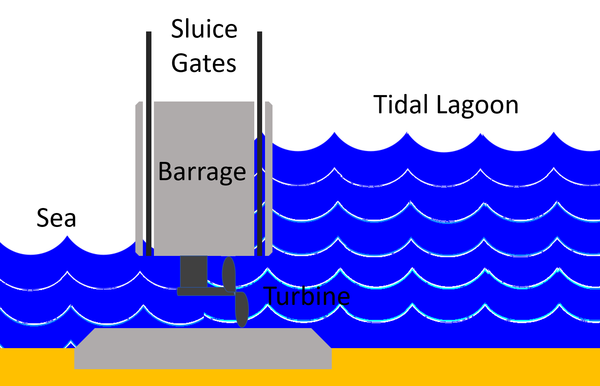Difference between revisions of "Tidal"
| Line 16: | Line 16: | ||
: 2. The water causes [[turbine]]s to turn. | : 2. The water causes [[turbine]]s to turn. | ||
: 3. The [[turbine]]s spin a generator which makes [[electricity]]. | : 3. The [[turbine]]s spin a generator which makes [[electricity]]. | ||
| + | |||
| + | ====Advantages==== | ||
| + | *Do not produce pollution. | ||
| + | *Very reliable (high tide occurs twice a day). | ||
| + | *No fuel costs. | ||
| + | *Power output can be varied by opening and closing sluice gates to control the water flow. | ||
| + | |||
| + | ====Disadvantages==== | ||
| + | *Cost to build is quite high. | ||
| + | *Prevent access to boats. | ||
| + | *Tidal height varies throughout the year. | ||
| + | *Damages habitats by not allowing the natural flow of the tides. | ||
Revision as of 09:55, 9 October 2018
Key Stage 3
Meaning
Tidal is an energy resource which uses tides to generate electricity.
About Tidal
- Tidal is a renewable energy resource.
- Tidal has energy in the gravitational potential energy store of water that is being pulled by the moons gravitational pull.
- Tides happen twice a day. Once when the The Moon is directly overhead and once when the The Moon is on the opposite side of the Earth.
Power
- 1. As the tide changes water passes through the pipes in the tidal barrage.
- 2. The water causes turbines to turn.
- 3. The turbines spin a generator which makes electricity.
Advantages
- Do not produce pollution.
- Very reliable (high tide occurs twice a day).
- No fuel costs.
- Power output can be varied by opening and closing sluice gates to control the water flow.
Disadvantages
- Cost to build is quite high.
- Prevent access to boats.
- Tidal height varies throughout the year.
- Damages habitats by not allowing the natural flow of the tides.
